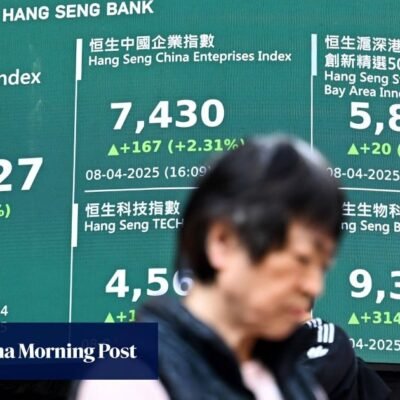Global stock markets plummeted on April 3, 2025, after sweeping tariffs were announced by the US, instigating similar behavior among most equity funds, especially the most temperamental.
The US stock market had its worst day since governments around the world shuttered vast swaths of their economies during the covid-19 pandemic in March 2020. This time, the President Donald Trump administration’s imposition of tariffs designed to upend the prevailing global economic order triggered the selloff.
The Morningstar US Market Index fell about 5%, but small caps bore the brunt of the day’s decline. The small-growth, small-blend, and small-value Morningstar Categories, on average, dropped between 6.4% and 6.9%. Value stocks, in general, held up better than growth but didn’t have much to crow about. The Morningstar US Value Index dropped 3.7%, while the Morningstar US Growth Index fell 5.9%.
Non-US stocks and the funds that own them held up better. The foreign large-blend, foreign large-growth, and foreign large-value categories and the foreign small/mid-growth and -value groups, on average, lost between 1.3% and 2.3%.
Among funds that Morningstar manager research analysts have under full coverage, those owning small- and mid-cap stocks, considered the most vulnerable to a recession, and companies with more speculative prospects or wobblier finances and business models fared the worst. Many of the worst-performing funds already had reputations for volatile performance.
Royce Small-Cap Opportunity RYPNX, for instance, is diversified across nearly 230 holdings, none of which takes up more than 1% of assets. The managers, however, gravitate to very small, statistically cheap stocks that often are under a cloud and allow their picks to cluster in sectors where they find opportunities, such as industrials and technology. More than two thirds of its holdings were in micro-cap stocks at the start of the year. It has been a feast-or-famine approach since the fund’s 1996 inception, and April 3 was a day of scarcity. Its investor share class shed 8.6%, worse than 99% of small-value category funds.
Fidelity Leveraged Company Stock FLVCX invests higher up the market-cap ladder but on the lower rungs of quality. Managers Mark Notkin and Brian Chang keep most of the portfolio in the shares of companies with BBB credit ratings—a notch above what’s considered high yield or junk bonds—or worse. While they’ve found some profitable contrarian ideas and turnaround stories among such fare over the years, the portfolio has always been a volatile brew that falls harder than the rest of the market in downturns. It was true to form on April 3, dropping 8.2%, almost double the average large-blend fund and Morningstar US Large-Mid Cap Index for the day.
Aggressive small- and mid-cap growth funds shared their small- and deep-value brethren’s pain. The notoriously volatile ARK Innovation ETF ARKK and its close relative American Beacon ARK Transformative Innovation ADNAX fell about 8% for the day, worse than 97% of mid-cap growth category peers. Both strategies pile into highly speculative companies on the bleeding edge of artificial intelligence, biotechnology, and other potentially transformative—but often contentious—technologies. Tesla TSLA, ARK Innovation’s top holding at more than 12% of assets, fell nearly 5.5% on April 3, as did online video game provider Roblox RBLX, which took up 7.3% of the ETF’s assets. Streaming television company Roku ROKU, at 8.5% of assets, plunged 15.6%.
Morgan Stanley Institutional Discovery MPEGX, another aggressive, highly active portfolio that piles into the shares of businesses with more potential than current earnings, also fell hard. The strategy, led by manager Dennis Lynch, dropped nearly 8.7%, worse than 99% of mid-cap growth category peers and more than 3 percentage points deeper than the Morningstar US Mid Cap Broad Growth Index’s loss. Top holding Cloudflare NET lost more than 10% on the day.
Funds and exchange-traded funds that seek less volatile stocks by design tempered losses. Invesco S&P 500 Low Volatility ETF SPLV and iShares MSCI USA Minimum Volatility Factor ETF USMV lost 0.89% and 1.20%, respectively, less than most large-value and large-blend funds. Conservative and dividend-focused actively managed funds, such as BNY Mellon Concentrated Growth ETF BKCG, American Century Equity Income ACIIX, ClearBridge Dividend Strategy SOPAX, and Vanguard Dividend Growth VDIGX, lost less than the broad market and most of their large-cap peers.
AMG Yacktman Focused YAFFX, run by established contrarians Stephen Yacktman and Jason Subotky, was able to lose less than large-value peers and benchmarks on April 3. This concentrated portfolio, which has nearly 42% of its assets in non-US stocks and more than a fifth of its portfolio in communication-services companies, held up relatively well. Its top holding at 10% of assets, French conglomerate Bollore SE BOL, slipped a relatively mild 1.6% for the day.
Non-US equity funds—not including sector strategies and those that use borrowed money to juice results—on average lost less than US equity funds, dropping about 2.3%, about 3 percentage points less than the typical US equity fund. Like the US, though, dividend-focused and low-volatility strategies held up best. Federated Hermes International Strategic Value Dividend IVFAX actually rose nearly 2%, while Schwab International Dividend Equity ETF SCHY and Invesco S&P International Developed Low Volatility ETF IDLV each gained more than 1%.
Artisan International ARTIX, run by eclectic manager Mark Yockey, was flat for the day, which was still better than 98% of the foreign large-growth category. It had more than half its assets in developed Europe and an overweight in utilities stocks like Britain’s National Grid NG., which rose almost 4.5%.
Morningstar analyst David Carey contributed to this report.





